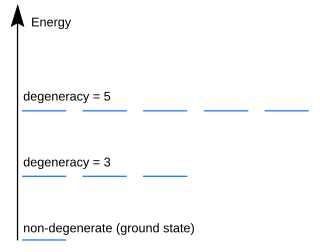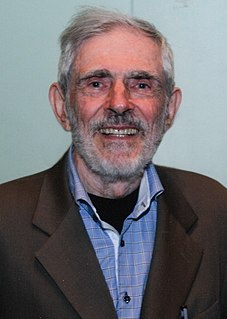Related Research Articles
In mathematics, particularly linear algebra and functional analysis, a spectral theorem is a result about when a linear operator or matrix can be diagonalized. This is extremely useful because computations involving a diagonalizable matrix can often be reduced to much simpler computations involving the corresponding diagonal matrix. The concept of diagonalization is relatively straightforward for operators on finite-dimensional vector spaces but requires some modification for operators on infinite-dimensional spaces. In general, the spectral theorem identifies a class of linear operators that can be modeled by multiplication operators, which are as simple as one can hope to find. In more abstract language, the spectral theorem is a statement about commutative C*-algebras. See also spectral theory for a historical perspective.

In linear algebra, the singular value decomposition (SVD) is a factorization of a real or complex matrix that generalizes the eigendecomposition of a square normal matrix to any matrix via an extension of the polar decomposition.
In mathematics, a self-adjoint operator on a finite-dimensional complex vector space V with inner product is a linear map A that is its own adjoint: for all vectors v and w. If V is finite-dimensional with a given orthonormal basis, this is equivalent to the condition that the matrix of A is a Hermitian matrix, i.e., equal to its conjugate transpose A∗. By the finite-dimensional spectral theorem, V has an orthonormal basis such that the matrix of A relative to this basis is a diagonal matrix with entries in the real numbers. In this article, we consider generalizations of this concept to operators on Hilbert spaces of arbitrary dimension.
In mathematics, especially functional analysis, a normal operator on a complex Hilbert space H is a continuous linear operator N : H → H that commutes with its hermitian adjoint N*, that is: NN* = N*N.
In mathematics, the spectrum of a matrix is the set of its eigenvalues. More generally, if is a linear operator over any finite-dimensional vector space, its spectrum is the set of scalars such that is not invertible. The determinant of the matrix equals the product of its eigenvalues. Similarly, the trace of the matrix equals the sum of its eigenvalues. From this point of view, we can define the pseudo-determinant for a singular matrix to be the product of its nonzero eigenvalues.
In mathematics, particularly in functional analysis, the spectrum of a bounded linear operator is a generalisation of the set of eigenvalues of a matrix. Specifically, a complex number λ is said to be in the spectrum of a bounded linear operator T if is not invertible, where I is the identity operator. The study of spectra and related properties is known as spectral theory, which has numerous applications, most notably the mathematical formulation of quantum mechanics.

In linear algebra, a Jordan normal form, also known as a Jordan canonical form or JCF, is an upper triangular matrix of a particular form called a Jordan matrix representing a linear operator on a finite-dimensional vector space with respect to some basis. Such a matrix has each non-zero off-diagonal entry equal to 1, immediately above the main diagonal, and with identical diagonal entries to the left and below them.
In mathematics, spectral theory is an inclusive term for theories extending the eigenvector and eigenvalue theory of a single square matrix to a much broader theory of the structure of operators in a variety of mathematical spaces. It is a result of studies of linear algebra and the solutions of systems of linear equations and their generalizations. The theory is connected to that of analytic functions because the spectral properties of an operator are related to analytic functions of the spectral parameter.
In mathematics, operator theory is the study of linear operators on function spaces, beginning with differential operators and integral operators. The operators may be presented abstractly by their characteristics, such as bounded linear operators or closed operators, and consideration may be given to nonlinear operators. The study, which depends heavily on the topology of function spaces, is a branch of functional analysis.

A physical quantity is said to have a discrete spectrum if it takes only distinct values, with gaps between one value and the next.
The spectrum of a linear operator that operates on a Banach space consists of all scalars such that the operator does not have a bounded inverse on . The spectrum has a standard decomposition into three parts:

In quantum mechanics, an energy level is degenerate if it corresponds to two or more different measurable states of a quantum system. Conversely, two or more different states of a quantum mechanical system are said to be degenerate if they give the same value of energy upon measurement. The number of different states corresponding to a particular energy level is known as the degree of degeneracy of the level. It is represented mathematically by the Hamiltonian for the system having more than one linearly independent eigenstate with the same energy eigenvalue. When this is the case, energy alone is not enough to characterize what state the system is in, and other quantum numbers are needed to characterize the exact state when distinction is desired. In classical mechanics, this can be understood in terms of different possible trajectories corresponding to the same energy.

Horace Chandler Davis is an American-Canadian mathematician, writer, and educator.
In mathematics, the resolvent formalism is a technique for applying concepts from complex analysis to the study of the spectrum of operators on Banach spaces and more general spaces. Formal justification for the manipulations can be found in the framework of holomorphic functional calculus.
In functional analysis, compact operators are linear operators on Banach spaces that map bounded sets to relatively compact sets. In the case of a Hilbert space H, the compact operators are the closure of the finite rank operators in the uniform operator topology. In general, operators on infinite-dimensional spaces feature properties that do not appear in the finite-dimensional case, i.e. for matrices. The compact operators are notable in that they share as much similarity with matrices as one can expect from a general operator. In particular, the spectral properties of compact operators resemble those of square matrices.

In mathematics, stability theory addresses the stability of solutions of differential equations and of trajectories of dynamical systems under small perturbations of initial conditions. The heat equation, for example, is a stable partial differential equation because small perturbations of initial data lead to small variations in temperature at a later time as a result of the maximum principle. In partial differential equations one may measure the distances between functions using Lp norms or the sup norm, while in differential geometry one may measure the distance between spaces using the Gromov–Hausdorff distance.
In functional analysis, the concept of a compact operator on Hilbert space is an extension of the concept of a matrix acting on a finite-dimensional vector space; in Hilbert space, compact operators are precisely the closure of finite-rank operators in the topology induced by the operator norm. As such, results from matrix theory can sometimes be extended to compact operators using similar arguments. By contrast, the study of general operators on infinite-dimensional spaces often requires a genuinely different approach.
In mathematics, the spectral gap is the difference between the moduli of the two largest eigenvalues of a matrix or operator; alternately, it is sometimes taken as the smallest non-zero eigenvalue. Various theorems relate this difference to other properties of the system.
In mathematics, the spectral abscissa of a matrix or a bounded linear operator is the supremum among the real part of the elements in its spectrum, sometimes denoted as
SLEPc is a software library for the parallel computation of eigenvalues and eigenvectors of large, sparse matrices. It can be seen as a module of PETSc that provides solvers for different types of eigenproblems, including linear and nonlinear, as well as the SVD. Recent versions also include support for matrix functions. It uses the MPI standard for parallelization. Both real and complex arithmetic are supported, with single, double and quadruple precision.
References
- ↑ Davis, C.; W. M. Kahan (March 1970). "The rotation of eigenvectors by a perturbation. III". SIAM J. Numer. Anal. 7 (1): 1–46. doi:10.1137/0707001.